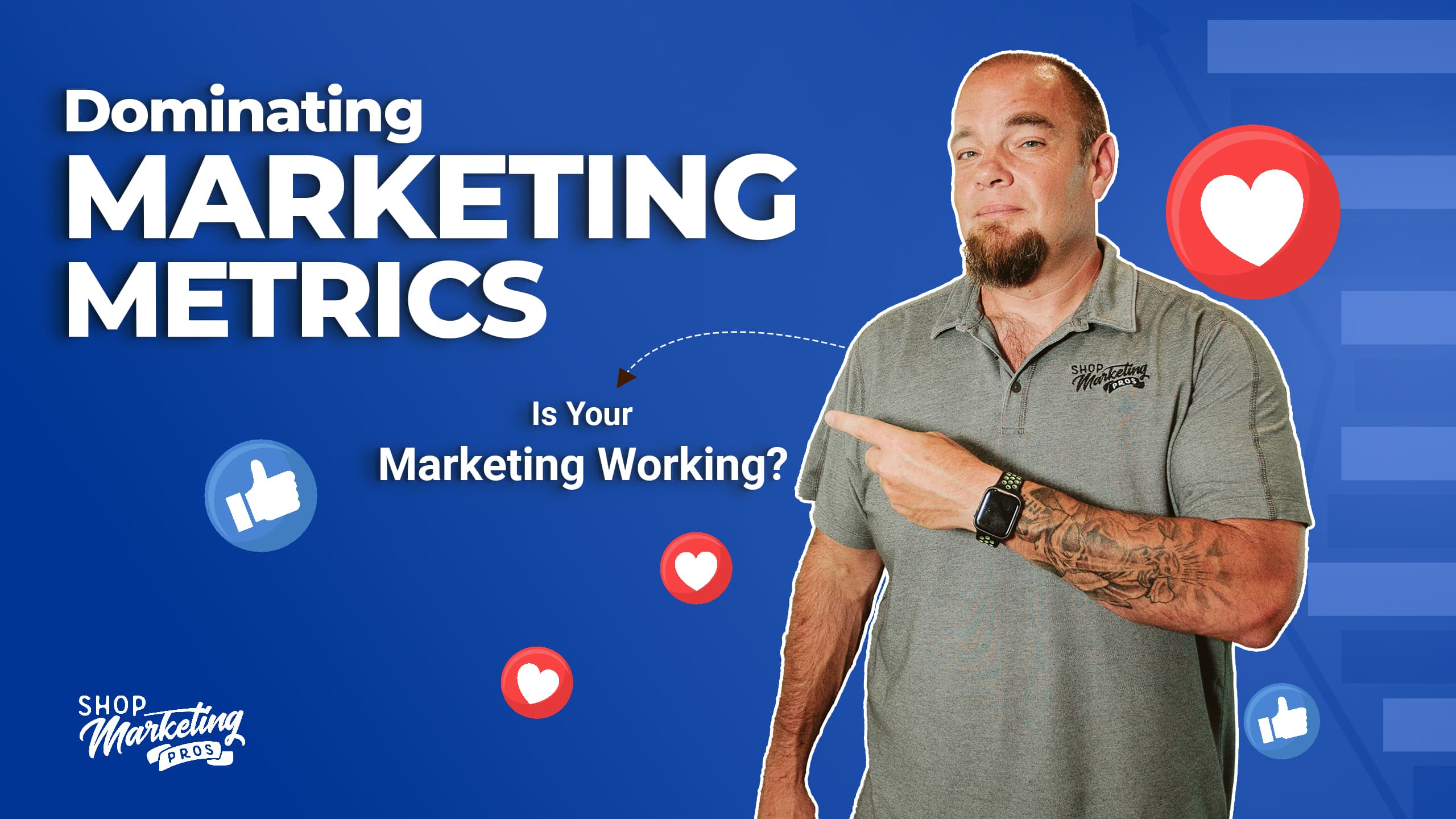You’ve probably heard the old saying, “You can’t improve what you don’t measure”. While I don’t believe that’s a literal truth, I understand the sentiment and agree with the overall idea. In marketing, you can certainly make improvements and never measure anything, but how will you know if things actually improved? How will you know which actions taken are the ones responsible for the improvements?
A much-needed movement has been happening across our industry for some years now, and that’s the movement of shop owners from being mechanics who just happen to own a business to being businessmen who just happen to be technically proficient at fixing cars. And with this move towards being businessmen, some focus must be given to understanding the basic principles of marketing and how to measure its effectiveness.
But where do you start when it comes to marketing KPIs? Google Analytics alone has thousands of data points – never mind Facebook insights, Google Ads metrics, email marketing, phone call tracking, impressions vs reach vs engagement – and how in the world do I measure things like direct mail and billboards?
Then there are vanity metrics, snake oil, and smoke and mirrors that marketers provide you to prove that what they’re doing is working when it’s actually not.
Measuring your marketing can be overwhelming, confusing, and a mix of other emotions.
My goal with this article is to bring some clarity and simplicity to this topic and give you a handful of numbers to look at so you can know if your marketing is working, or if it isn’t.
The Handoff From Marketing to Sales
Before I get too far into this, I need to bring some awareness to the handoff from marketing to sales.
The job of marketing is to get your phone ringing and your online scheduling forms to be filled out. Once that happens, marketing has done its job and it’s time for sales and customer service to kick in.
At Shop Marketing Pros, we tend to work with the best of the best shops. Most of our clients have great service advisors who have great phone skills, but we still run into situations where the marketing we’re doing is working but it’s not resulting in enough new work for the shop.
We record all of the phone calls that come in through Google Ads so we can make sure we’re sending our clients quality leads. Those recorded calls have helped us to show the shop owner that their marketing is working but their service advisors aren’t capitalizing on the opportunities.
We’ve heard everything from advisors never asking for the appointment, to talking potential clients out of the sale by telling them how “expensive” a job is going to be, to being downright rude to people. I know of at least one case where an advisor was fired when the owner heard the recorded calls.
My point is this. Just because your revenue isn’t climbing doesn’t mean your marketing isn’t working.
On another note, just a couple of weeks ago I had a shop owner call me because he thought he needed marketing. When talking to him I learned that he was seeing 60 cars per week with an average repair order of $300. I told him he didn’t need marketing but rather he needed a coach.
When shop owners are having revenue problems, they often think marketing is the answer. But there’s so much more to running a successful business than just having great marketing. You need to ethically make the most of every car that comes through your shop. Then there’s also this little thing called profitability. Remember, if you have $300k in sales with a 20% profit margin you’re making more money than a shop doing $1M in sales with a 5% margin.
The Five Most Important KPIs In Auto Repair
Hang in there with me. I’m still not to the marketing metrics yet. I couldn’t justify writing this article without giving you these KPIs first. They’re too important, and only one of them has anything to do with marketing.
Average Repair Order (ARO)
This goes right back to the shop owner I told to invest in a coach before investing in marketing. Marketing will get more cars in your bays, but do you actually need more cars? Having a high car count with a low average repair order is a surefire way to own a business you hate and have stress levels that no person should endure. If your ARO is less than $500, invest in a coach, not marketing.
Average Estimate
Coach Chris Cotton was the first coach I ever heard talking about this KPI. He has a point. If you’re not giving the estimates, you can’t sell the work. A low average estimate can be caused by factors like not inspecting every vehicle, not having enough service advisors, or whoever is responsible for writing the estimates just being lazy. If you have a low average estimate, you’ll certainly have a low average repair order. Chris says the average estimate he looks for from his shops is $1500 and if it’s less than $1000, they’re digging into processes to find the problem.
Comeback Rate or Customer Satisfaction
I put these two together because they work hand-in-hand. The job of an auto repair shop is to fix cars. If you don’t actually fix the cars, you’ll always be looking for new clients. It’s also your job to make the client happy. Even if you’re great at fixing the cars, if your service advisor is a jerk or if your clients aren’t satisfied for any given reason, you’ll always be looking for new clients. It’s imperative that you keep every client you possibly can. It’s rare that you make money on a client’s first visit because the cost of acquiring a new client is not cheap. You have to make it up with their lifetime value (LTV).
Profit Margin
If you’re doing millions in revenue with little to no profits, you’re going broke. Revenue is a vanity metric until there are profits attached. A healthy auto repair shop will have a 20% profit margin. If you’re under 20% but close, make some minor adjustments and get to 20%. A few percent is easy to find. If you’re way under 20%, get a coach. If you have a coach and you’re still under 20%, you need to actually start doing what your coach is telling you to do 😂.
Gross Revenue or Car Count
I also put these two together because they work hand-in-hand. There’s a saying “Revenue fixes a lot of problems”, and that’s true, but it’s only one piece of the puzzle. You can have a ton of revenue and still be losing money. You have to be profitable. But when you have a healthy business and you’re maintaining that 20% profit margin, revenue is your best friend, and that’s where marketing comes into play.
Important Marketing KPIs
Ok, we’re finally there. Here are the marketing KPIs you should be looking at to determine if your marketing is working
The KPIs you look at are going to be directly related to the types of marketing you’re doing. I’m breaking the KPIs down by type of marketing and then giving you a few “general” KPIs that should give you a basic overview of whether or not your marketing is working.
Website KPIs
Traffic – how many visits did your website get? But it’s not that simple. Because an auto repair shop is a local business, you want to look at the traffic from your local area. I find it’s good enough to look at the traffic coming from within your state, or within a 20-mile radius of your shop, though you can’t exactly sort it like that so you need to get creative with city, county, zip code, etc. Your website traffic should always be growing and you should compare it to the same months during previous years.
Page Views – you want to look at the pages people are viewing on your website. This can tell you the type of content your visitors are interested in so that you can create more, similar content. Your homepage will nearly always be the most visited page of your website, but specialty shops should always have pages dedicated to their specialty. If you’re a diesel specialist and you have a page about bulletproofing Powerstrokes and that page gets a lot of traffic, it would make sense that a page about Cummins killer dowel pins would also perform well.
Bounce Rate – your bounce rate is the number of people who enter your website and leave without visiting any other pages. For a website with an active blog, I typically see a bounce rate of around 75%. This is because people from around the world may find your website for very specific topics that would be covered in a blog, but they are too far from you to ever become a client, so they read the blog and then leave. For websites without a blog, I like to see a 65% or less bounce rate. You also need to realize that many people are only visiting your website to get contact information, and most modern websites have that information prominent on the homepage. But, if you see an abnormally high bounce rate, it should tell you something is wrong with your website. It could be as simple as an outdated design that turns people away or things like excessive popups. It could be many things that are causing this.
Google Ad KPIs
Click Through Rate (CTR) – this metric tells you how many times your ads are being clicked in relation to the number of times the ad is being shown. If you have a low click-through rate, you’re going to have a poor ad quality score which will lead to a poor average position, high cost per click, and overall poor ad performance. The click-through rate is primarily dictated by putting the right message in front of the right audience, so the words in your ad should convince the searcher that your ad is the one he/she should click on based on the search terms they used.
Average Position – this metric shows you where your ad is displaying on the page on average. You want your average position to be between 1 and 2. This means that your ad is displayed in the top two spots on page one of the search results. A high average position is earned by having a high ad quality score.
Ad Quality Score – this is one of the most important metrics that nobody talks about anymore. Ad quality score is exactly what it says it is. It’s a score given to your ads that is representative of how well your ads have been built. It is based on how closely your ad matches the search query, the expected click-through rate of that ad, and the overall landing page experience. A great ad quality score means cheaper clicks and more clicks, and isn’t that what everyone wants?
Social Media KPIs
The different social media platforms have their own metrics and may refer to them in different terms, so I’m going to talk in terms of Facebook.
Page Likes – I really hate having this as my top metric because this is another one of those vanity metrics. The truth is, you can buy likes, and that’s about the worst thing you can do. So when I talk about page likes I want to be clear that I’m talking about page likes that have come from a real, relevant audience of people who want to hear from your brand. The thing is, only about 2% of your audience will see organic posts from your shop’s page, so you need to have as many page likes as possible to get more eyes on your content.
Engagement – the engagement metric is a metric that measures when people like, comment, or share a post. When people do this it shows that they are interested in the content you’ve put out there. So high engagement numbers show you that you’re doing things right. Your goal should be to always see that engagement number increasing.
Impressions – because social media is primarily about know, like, trust – and brand building, you want eyes on your content. The more impressions you have, the more opportunities for eyes on your content. The more impressions you have, the more opportunity for engagement. But be aware, impression numbers are usually pretty large numbers. They’ll make you think you’re accomplishing something when you’re not. It’s still important though because impressions have to happen before engagement can.
The Truth About Organic Social Media Marketing – you cannot measure the return on investment from organic social media marketing. When I say organic, I mean that you’re not paying the social media platform itself. Paid social media advertising can be measured. That’s not what I’m talking about here.
Organic social media marketing is about getting people to know, like, and trust you and your team. It’s about educating people and sharing your expertise. It’s about entertaining people and sharing your company culture. It’s about showing people a side of your team that makes them want to do business at your shop.
So yes, you want to measure and grow your organic social media marketing, but if you try to assign a dollar-measured return, you’re going to stop doing something that’s actually an integral part of your marketing strategy.
Email Marketing KPIs
Open Rate – this metric tells you how many people opened your email by percentage. I like to see a 20% or better open rate for my client’s emails. If the open rate is low, the subject line or the from line is usually to blame. The subject line should capture the reader’s attention and the from line should tell them who the email is from. If your open rate is low, play with these two things to get it higher.
Click-Rate – this metric tells you how many people clicked on a link in your email, by percentage. There’s a caveat here. You need to have links in your emails to have a click rate. This is where you get to share things like your latest blog posts, new services that are listed on your website, etc.
My Unpopular Opinion – I don’t care if people open an email much less click on it. I want your name to be seen in their inbox. It keeps your shop top of mind. Opening and reading the email, and clicking through to the shop’s website is just icing on the cake.
Direct Mail KPIs
Turn-In Rate – this is the number of mail pieces that get turned in at your service counter compared to the number that was mailed out. You can also look at this in terms of revenue vs what it cost you to send the mailer. This is really the only metric for direct mail unless you use tracking phone numbers and vanity URLs, which is a great but normally underutilized measure.
General KPIs
There are some general KPIs you can look at to tell you if your marketing is working. These are KPIs that aren’t directly related to a specific type of marketing but are based more on the shop’s performance as a whole.
An important note about these KPIs is they should be compared to the same date range year over year. So if you’re looking at July 2023 for example, you shouldn’t compare it to the previous months but instead compare it to July 2022, July 2021, July 2020, and however far back you want to go. There are ebbs and flows throughout the year, but those are typically on the same timeline each year. We know that back-to-school, Christmas, and even events like a state fair can cause slowdowns. The goal is to grow each year, and that may still mean your July is slower than January of the same year..
Car Count – this is the ultimate metric that tells you if your marketing is working. You can’t count on revenue alone because maybe you fired that slack service advisor and have a rock star in place now. Your revenue could have literally doubled without your marketing outperforming the previous year. Revenue is a liar when it comes to marketing, car count is not.
I do want to make the point though that we work with a few clients who came to us looking to change their customer avatar. They wanted a higher quality client, fewer cars, and a higher ARO. So you do have special considerations to take in cases like these.
Average Repair Order – this goes along with the example I just gave. Great marketing can positively impact your ARO. This could be anything from shifting your marketing to attract a completely different customer to putting a strong waiting room marketing strategy into place that helps upsell work by piquing your waiters’ interests in additional services.
New Clients – if you’re doing a great job fixing cars and providing great customer service, revenue growth is going to occur naturally. If you’re getting 10 new clients per month organically, then over the last 3 years you have acquired 360 new clients. If you keep your clients then your revenue is going to have climbed in relation to the new clients. But if your marketing is working, you should be growing the number of new clients you get each month rather than the number being steady. So in theory, 3 years ago you were getting 10 new clients per month organically and today you may be getting 40 new clients per month with marketing. So measuring your new clients per month is a great indicator of whether or not your marketing is working.
In Conclusion
Measuring the effectiveness of your marketing is not hard to do. Every one of these KPIs can fit into a spreadsheet, scorecard, or dashboard that you can see at a glance on one screen. The numbers are easy to get and easy to understand.
Monitoring these metrics on a monthly basis will help you to make sure you’re spending your marketing dollars wisely.
If you need help with your marketing, my team at Shop Marketing Pros is the most competent, most friendly marketing team you’ll ever work with. We’ll get to know you better than any other marketing team in the industry, and our philosophy of doing marketing that’s designed to get people to know, like, and trust you make for a rock-solid marketing strategy.
If you’d like to learn more in a no-pressure environment, schedule a discovery call here.




